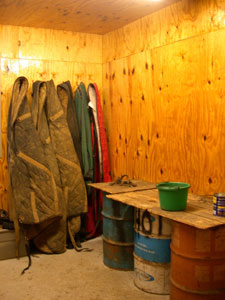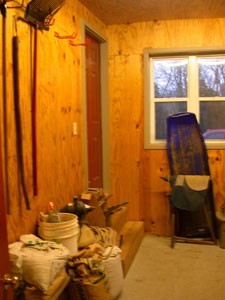Ashley Griffin, University of Kentucky
The feed room is seldom larger than a box stall. Organize it for convenience and easy housekeeping. Plan storage for feed materials, equipment, and tools. Provide an uncluttered traffic pattern to reach the stored materials without interference. Keep the storage area as dust-free as possible.
Hay may be stored in an overhead loft or on the ground floor. Small rooms and narrow doors are inconvenient for storing hay and add to the labor required to handle it, both in and out of storage.
Grain feed must be stored in vermin-proof bins or containers. Metal containers, such as large garbage cans and wood bins with tight lids, are excellent for limited-bulk feed storage. Homemade and commercial grain bins are used for storing grain in large quantities.
Feed and storage rooms


The feed room should be well-lighted and equipped with convenience outlets. Provide 150 watts of light and at least two convenience outlets in the feed room. The entrance door to the feed room should be at least 4 feet wide and equipped with a latch so that a loose horse cannot get into the feed. A good control program is essential.
Use the following guidelines to figure how how much space is needed to store feed:
- 1 3/4 lb of hay and 1 lb of grain per day per 100 lb of the horse’s weight.
- Baled hay will weigh approximately 10 lb/cu ft, and a ton will occupy approximately 200 cu ft.
- Whole oats weigh approximately 26lb/cu ft (80 cu ft/ton).
- Ear corn weighs about 28 lb/cu ft (70 cu ft/ton);
- Bulk feed weighs about 40 lb/cu ft (50 cu ft/ton).
The amount of storage space needed will depend on the number of horses, their total weight, and how often the feed supply is to be replenished.


